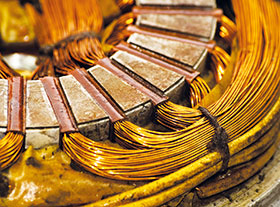

The following five factors can produce their own particular type of damage and leave their own special imprint on a bearing. Consequently, by examining a damaged bearing it is possible to determine the root cause of the damage so that the requisite actions can be taken to prevent a recurrence.
1. Electrical erosion
Electrical erosion or arcing, can happen when a current passes from one ring to the other through the rolling elements. The extent of the damage depends on the amount of energy and its duration. However, the result is usually the same: pitting damage to the rolling elements and raceways, rapid degradation of the lubricant and premature bearing failure. To prevent damage from electric current passage, an electrically insulated bearing at the non-drive end is usually used. There are two types of insulated bearings available from SKF: Insocoat bearings and hybrid bearings.
2. Inadequate lubrication and contamination
If the lubricant film between the rolling elements and raceways is too thin due to inadequate viscosity or contamination, metal-to-metal contact occurs. Check first whether the appropriate lubricant is being used and that re-greasing intervals and quantity are adequate for the application. If the lubricant contains contaminants, check the seals to determine if they should be replaced or upgraded. In some cases, depending on the application, a lubricant with a higher viscosity may be needed to increase the oil film thickness.
3. Damage from vibration
Motors that are transported without the rotor shaft held securely in place can be subjected to vibrations within the bearing clearance that could damage the bearings. Similarly, if a motor is at a standstill and subjected to external vibrations over a period of time, the bearings can also become damaged. Secure the bearings during transport in the following manner: lock the shaft axially using flat steel bent in a U-shape, while carefully preloading the ball bearing at the non-drive end. Then radially load the bearing at the drive end with a strap. In case of prolonged periods of standstill, turn the shaft from time to time.
4. Damage caused by improper installation and set-up
Common mistakes in installation include using a hammer or other similar tools to mount a coupling half or belt pulley onto a shaft, misalignment, imbalance, excessive belt tension, and incorrect mounting resulting in overloading. To prevent this, use precision instruments such as the SKF shaft alignment tool and Microlog vibration analyser to check alignment and vibration, and the appropriate tools and methods when mounting bearings.
5. Insufficient bearing load
Bearings always need to have a minimum load to function well. The damage will appear as smearing on the rolling elements and raceways. In order to prevent this, make sure to apply a sufficiently large external load to the bearings. It is most important to remember this when using cylindrical roller bearings, since they are typically used to accommodate heavier loads. This does not apply to preloaded bearings.
For more information contact Samantha Joubert, SKF South Africa, +27 (0)11 821 3500, [email protected], www.skf.com
| Tel: | +27 11 821 3500 |
| Email: | [email protected] |
| www: | www.skf.co.za |
| Articles: | More information and articles about SKF South Africa |

© Technews Publishing (Pty) Ltd | All Rights Reserved